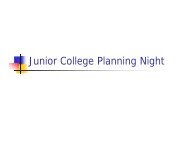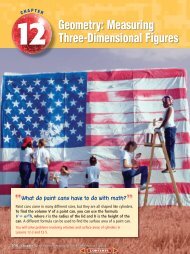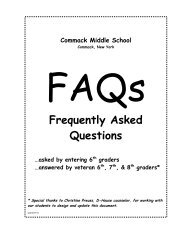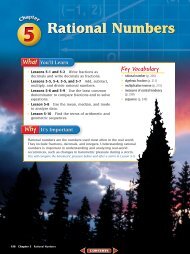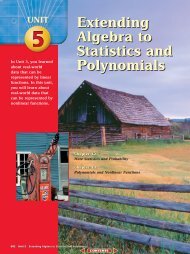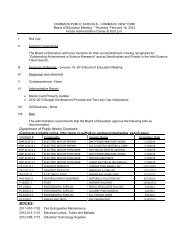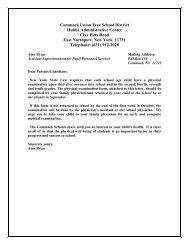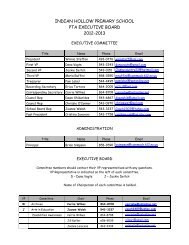Preparing for the Regents Examination Geometry, AK
Preparing for the Regents Examination Geometry, AK
Preparing for the Regents Examination Geometry, AK
Create successful ePaper yourself
Turn your PDF publications into a flip-book with our unique Google optimized e-Paper software.
37 Score Explanation<br />
4 Secant points of intersection are (0, 5) and (2, 4), and an appropriate explanation is<br />
given.<br />
3 Secant is given, but graph is incorrect.<br />
2 Graph is shown, but secant is not given.<br />
1 Secant is given, but graph is not shown.<br />
0 A zero response is completely incorrect, irrelevant, or incoherent or is a correct response<br />
that was obtained by an obviously incorrect procedure.<br />
Part IV<br />
For each question, use <strong>the</strong> specific criteria to award a maximum of 6 credits.<br />
38 Score Explanation<br />
6 Any appropriate method is used to prove that ABCD is a parallelogram, but not a rectangle.<br />
For example: showing that <strong>the</strong> diagonals bisect each o<strong>the</strong>r but are not congruent,<br />
or showing that no consecutive sides have negative reciprocal slopes.<br />
5 An appropriate method is used, but a single computational error is made.<br />
4 An appropriate method is used, but two computational errors are made.<br />
3 An appropriate method is used to prove that ABCD is a parallelogram but does not<br />
show that it is not a rectangle.<br />
2 An appropriate method is used to prove that ABCD is a parallelogram, but more than<br />
two computational errors are made and student does not show that it is not a rectangle.<br />
1 An appropriate method is used, but ABCD is not shown to be a parallelogram, and<br />
multiple computational errors are made.<br />
0 A zero response is completely incorrect, irrelevant, or incoherent or is a correct response<br />
that was obtained by an obviously incorrect procedure.<br />
Practice <strong>Regents</strong> <strong>Examination</strong> Three<br />
(pages 497–504)<br />
Part 1<br />
Allow a total of 56 credits, 2 credits <strong>for</strong> each of <strong>the</strong> following correct answers. Allow credit if <strong>the</strong> student has<br />
written <strong>the</strong> correct answer instead of <strong>the</strong> numeral 1, 2, 3, or 4.<br />
1 (2) 50<br />
2 (4) 16 : 25<br />
3 (4) (7, 7 √ 3 )<br />
4 (2) 18 cm 2<br />
5 (3) {2, 7, 10}<br />
6 (3) (3, 6.5)<br />
7 (3) 80 √ 3<br />
8 (3) ABCD is a parallelogram<br />
whose diagonals<br />
bisect each o<strong>the</strong>r.<br />
9 (2) 2 _ <br />
3<br />
10 (2) 156<br />
11 (2) (x 3) 2 (y 7) 2 2<br />
12 (3) y 1 _ x 4<br />
2<br />
13 (3) d 5<br />
14 (4) 11<br />
15 (1) 60<br />
16 (2) 32 √ 3<br />
17 (2) 16 16 √ 2 <br />
18 (4) x 1<br />
19 (1) 5<br />
20 (2) y 5x 2<br />
21 (3) 4 √ 3<br />
22 (1) perpendicular bisectors<br />
of <strong>the</strong> sides<br />
23 (3) 120<br />
24 (4) obtuse<br />
25 (3) 60<br />
26 (4) 210<br />
27 (1) The perpendicular<br />
bisector of <strong>the</strong> chord<br />
of a circle bisects <strong>the</strong><br />
intercepted arc.<br />
28 (1) (3, 5)<br />
Practice <strong>Regents</strong> <strong>Examination</strong> Three 143




